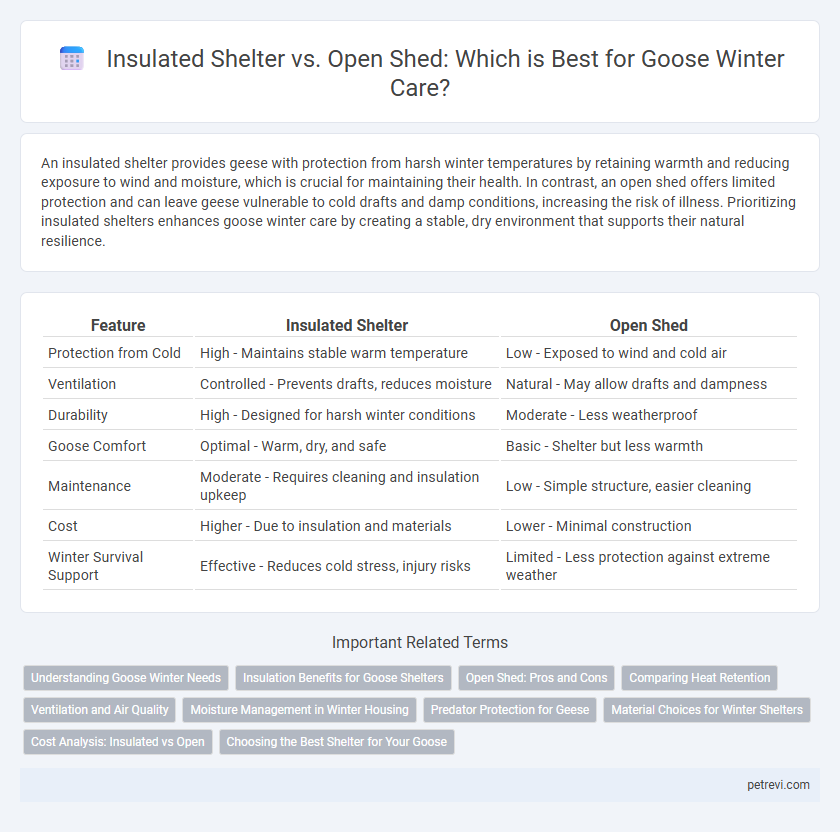An insulated shelter provides geese with protection from harsh winter temperatures by retaining warmth and reducing exposure to wind and moisture, which is crucial for maintaining their health. In contrast, an open shed offers limited protection and can leave geese vulnerable to cold drafts and damp conditions, increasing the risk of illness. Prioritizing insulated shelters enhances goose winter care by creating a stable, dry environment that supports their natural resilience.
Table of Comparison
| Feature | Insulated Shelter | Open Shed |
|---|---|---|
| Protection from Cold | High - Maintains stable warm temperature | Low - Exposed to wind and cold air |
| Ventilation | Controlled - Prevents drafts, reduces moisture | Natural - May allow drafts and dampness |
| Durability | High - Designed for harsh winter conditions | Moderate - Less weatherproof |
| Goose Comfort | Optimal - Warm, dry, and safe | Basic - Shelter but less warmth |
| Maintenance | Moderate - Requires cleaning and insulation upkeep | Low - Simple structure, easier cleaning |
| Cost | Higher - Due to insulation and materials | Lower - Minimal construction |
| Winter Survival Support | Effective - Reduces cold stress, injury risks | Limited - Less protection against extreme weather |
Understanding Goose Winter Needs
Goose winter care requires insulated shelters that maintain consistent warmth and protect against harsh winds and moisture, ensuring optimal body temperature regulation. Open sheds expose geese to fluctuating temperatures and dampness, increasing the risk of illness and frostbite. Effective winter housing balances ventilation with insulation to support the birds' natural behaviors and health.
Insulation Benefits for Goose Shelters
Insulated shelters provide superior temperature regulation for geese during winter, reducing heat loss and preventing cold stress that can weaken their immune system. Proper insulation materials such as foam boards or straw bales maintain a stable internal environment, minimizing drafts and moisture buildup that commonly cause respiratory issues. This controlled climate fosters better health, higher energy retention, and improved overall winter survival rates for geese compared to open sheds.
Open Shed: Pros and Cons
An open shed offers excellent ventilation, which helps prevent moisture buildup and respiratory issues in geese during winter. However, it provides limited protection against harsh winds, snow, and freezing temperatures, potentially leading to increased energy expenditure for warmth. Proper bedding and strategic placement can mitigate some downsides, but open sheds generally require supplemental measures to ensure optimal goose winter care.
Comparing Heat Retention
An insulated shelter provides superior heat retention for geese during winter by minimizing heat loss through thick, insulated walls and secure doors, maintaining a stable and warm environment. In contrast, an open shed offers minimal protection against cold winds and low temperatures, resulting in significant heat dissipation and reduced comfort for the birds. Proper insulation reduces the risk of hypothermia and supports the health and productivity of geese in harsh winter conditions.
Ventilation and Air Quality
Insulated shelters provide controlled ventilation that helps maintain stable temperatures while reducing drafts, crucial for preventing respiratory issues in geese during winter. Open sheds promote better natural airflow but can expose geese to cold winds and moisture, potentially compromising air quality and increasing the risk of illness. Proper ventilation in insulated shelters balances fresh air intake with warmth retention, ensuring optimal air quality and comfort for geese in harsh winter conditions.
Moisture Management in Winter Housing
Insulated shelters provide superior moisture management for geese in winter by reducing condensation and maintaining dry bedding, crucial for preventing respiratory issues and foot problems. Open sheds expose geese to fluctuating humidity and wind-driven moisture, increasing wetness and chill risk. Effective ventilation in insulated shelters balances moisture control while preserving warmth, ensuring optimal health during harsh winter conditions.
Predator Protection for Geese
Insulated shelters provide superior predator protection for geese during winter by offering a sturdy, enclosed environment that minimizes exposure to foxes, raccoons, and other threats. Unlike open sheds, insulated shelters limit entry points and maintain consistent warmth, reducing the risk of geese becoming vulnerable due to cold-related stress or escape attempts. Secure doors, reinforced walls, and elevated flooring in insulated shelters enhance safety, making them the preferred choice for effective predator deterrence in winter care.
Material Choices for Winter Shelters
Insulated shelters for goose winter care typically use materials like rigid foam panels, fiberglass insulation, and weather-resistant wood to maintain consistent warmth and protect against harsh cold. Open sheds often rely on durable, untreated wood or metal with windbreaks but lack thermal barriers, making them less effective in extreme winter conditions. Choosing high-quality, moisture-resistant materials in insulated shelters significantly improves thermal retention and overall goose health during winter months.
Cost Analysis: Insulated vs Open
Insulated shelters for geese typically involve higher initial costs due to materials such as foam panels and weatherproofing, but they significantly reduce heating expenses during winter by maintaining stable indoor temperatures. Open sheds, while cheaper to build, require additional bedding and may increase energy costs if supplemental heat sources are needed to protect geese from extreme cold. Over time, the investment in insulated shelters can lead to cost savings by minimizing energy consumption and reducing the risk of cold-related health problems in geese.
Choosing the Best Shelter for Your Goose
Choosing the best shelter for your goose in winter requires prioritizing insulation over openness to ensure warmth and protection from harsh weather. An insulated shelter maintains a stable temperature, reduces drafts, and prevents cold stress, which is crucial for goose health and egg production. Open sheds expose geese to wind, moisture, and temperature fluctuations, increasing the risk of illness and hypothermia during cold months.
Insulated Shelter vs Open Shed for Goose Winter Care Infographic

 petrevi.com
petrevi.com